Rake Angle
During 2010 and 2011, Designer extraordinaire Adrian Newey designed blown exhaust on RedBull F1 car has been the most obvious example of F1 rival copy-catting in 2011. Adrian Newey is taking the sanguine approach to questions about the flexibility of his car’s front wings (especially from the boys at McLaren) by calling them “a bit boring.”
“To be honest, it’s a bit boring,” he said. “I’ve had a season of people moaning about our front wing (flexibility) last year. The tests were made more rigorous by the FIA, it’s examined in great detail… I mean, frankly, I think it’s an effort by one team in particular to get a change in regulations because the regulations are very clear in terms of what you can and cannot do with the front wing. The rest comes down to how you run the car. We choose to run the car with quite a lot of rake; that means high at the rear, low at the front. Others, McLaren for instance, have chosen to take the opposite route. They run the car quite low-rake. Once you run the rear low, which means the front wing is automatically high.”

But journalist Ralf Bach wrote that the RB7's so-called 'rake' is also being emulated. The aggressive 'rake' - the car's attitude from front to rear - is the most likely reason the Red Bull has generated additional downforce amid the mystery previously attributed to flexing front wings.
“Der Spiegel” said Force India and Ferrari are the latest examples of teams emulating Red Bull's high rear end, with the result that the front of the cars is lower to maximise the ground effect component of front-wing downforce, (with the use of exhaust-blown diffusers to retain rear downforce). Front-wing ground effect has always had a role to play, but the current emphasis is perhaps a consequence of the new technical regulations introduced for the 2009 season, which permitted the front-wing to be much closer to the ground. "You can see clearly that the Red Bull sits higher at the rear," an unnamed FIA official is quoted as saying.
In this time Mercedes' Ross Brawn, however, doubts that simply copying Red Bull is the answer: "A copy is never as good as the original," he said.
What is the Rake Angle? As over 45% of the downforce of a car comes from undertray and around 35% from the rear, this is a crucial area to get right. But it’s not just a case of raising the ride height; work has to be done on bodywork, floor and exhausts to get the maximum. Basically the Rake Angle is the deviation of the floor plane from the horizontal. Positive rake angle is higher end, and negative rake angle is higher front of the car. Negative rake is not in use in racing.
"Wait," you say, "they have flat bottoms, they can't possibly be using ground effects to keep them on the ground." Wrong. On any Formula 1 car, and on any prototype LMP car by the way, the nose part of the flat bottom is closer to the ground than the tail portion. Resultant angle is referred to as the rake angle, which is typically 2-3 degrees. That small rake angle creates a shallow ground effects tunnel which produces the vast majority of the total downforce generated by the car. As anyone who has seen these cars can attest, the angle that the flat bottom makes with the road is barely perceptible, yet that same small angle makes a huge difference in the downforce generated by the car. Typically if a team is experimenting with a large change in rake angle set-up for a particular track they might crank in a 2-3 millimeters change in the height of one end of the car or the other. That should indicate how critical the rake angle is.
There are two significant effects of this in that a steeper rake angle will accelerate the airflow beneath the car due to a greater release of pressure as it flows past the lowest point of the floor. A rake angle generates a venturi-like effect under the floor, where the majority of the ground effects (or downforce) is generated. This angle is extremely sensitive, even a few milimeters one way or the other, either on the front or rear end of the car can have a significant effect on downforce. A sportscar with almost 10m² (or cca 6m² in case of Formula 1 car) of bottom area has huge potential for producing ground effects downforce. But this will only work if you are producing something really precise and stiff facing the ground.
According to engineers of rival teams, the higher rear end of the Red Bull artificially adds volume to the diffuser, hence makes it "think" it's bigger than it really is. The whole concept seems to be more efficient at creating overall pressure change and downforce from the floor and the diffuser. Beacuse from 2011 diffuser regulation changes, difusser have smaller angle of the walls, and by raking the car (lovering front and rising rear end of the car), it effectively makes the diffuser steeper, as they are so tightly rescricted on exit height. Newey actualy make the diffuser steeper without working against the rules. Deffuser actualy „think“ that he have steeper angles and actualy increases diffuser angle relative to the ground. It's also very difficult to keep the diffuser working well at high rear ride-heights - with the increased height from the flor, a lot of air can leak into the diffuser from the sides, reducing its overall performance. So, to do that efficiently, you have to seal sides of the diffuser to prevent air leak into the diffuser. But around year 2011, Red Bull can use the exhaust gases and their sidepod design more effectively than any other team to 'seal' the diffuser and keep the airflow working through this under-floor area. After blown diffuser was banned, they have to look on other possibilities to seal diffuser.
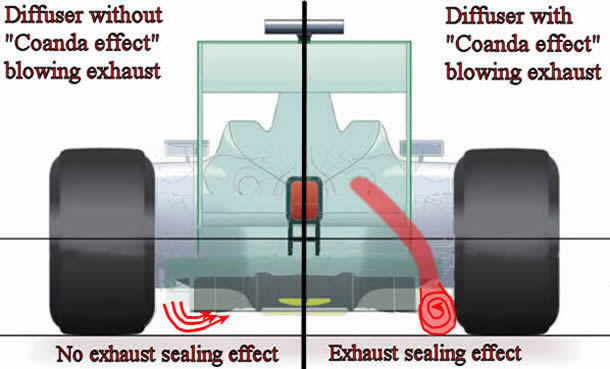
So what is solution now after exhaust sealing effect was impossible to implement? So why aren't all the teams jacking up the rear ride height? Well, as we discused before, when rake angle goes up, the sides of the floor move away from the ground, which reduces ground effect as low pressure leaks from the upper side of the underfloor. To increase rake angle you must also seal the floor using complex aerostructures that stem from the front wing. We often talk about the Y250 vortex for a reason: a stable vortex that can span a great distance along the car will improve that seal.
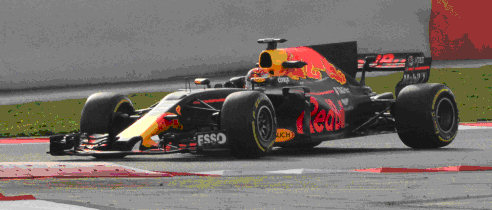
This might also have an impact on the centre of pressure which should move it forward. In this way is possible to, at higher speed, pull front of the car closer the ground, front wing included, to get visual effect of flexi wings. It's not the case that RedBull wing flexing so much, it was whole front of the car. To add to this, carbon fibre can be weaved in a certain way to behave differently under different loads. The theory is that the RedBull RB6 and RB7 wing flexes outwards and down due to a sophisticated layering process of the carbon composite material. But not so much as rival teams try to prove. It is actual movement of the car body, and in minor quantity, wing flexing itself.
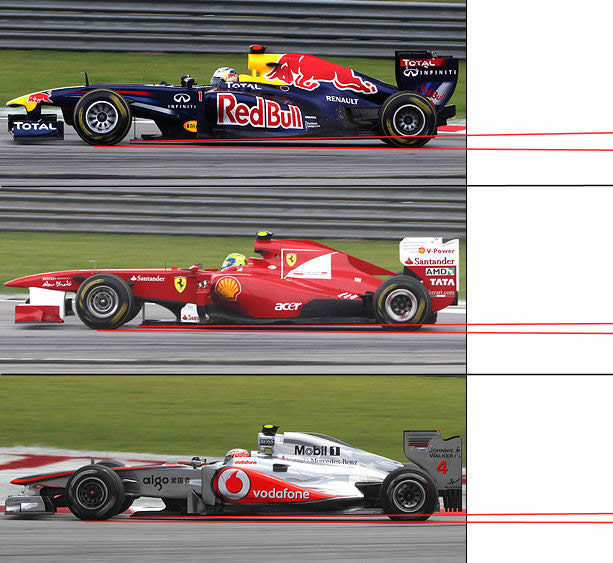 |
We can easily see that the RB7 is in fact running a high rake angle. The rear end of the car is much higher than the front end. |
Furthermore, the nose-down attitude of the car puts the front wing further into ground effect, improving not only its performance but all of the the components downstream, as downforce is increased but not to the cost of additional drag.
The trick also comes from being able to find a speed threshold whereby you’re effectively switching off the rear wing. This happens when the car's rake is reduced: as the load at the back builds with speed, the car is forced toward the ground, which in-turn rotates the wing and overloads it, stalling flow, both reducing downforce and drag. Few degree of rotation is enough.
But note that every part of the Red Bull needs to be looked at as a whole concept, not individual pieces. And it's the sum of all parts that make the RB6 and RB7 and all RB-s after that a fantastic cars. Rival teams such as McLaren and Ferrari cannot just simply jack the rear end of the their car and expect a sudden gain in downforce…
The other major effect is on the weight transfer under braking or acceleration as the mass of the car is more or less 'preloaded' toward the front end.
But all of this is not so simple. You have to be careful with setup of the car. Static rake (car is stationary) is one thing, but really what you need to know is where your rake is in dynamic conditions and have an idea where your rake should be at certain points of the track. You have to calculate roll center of the car and pitching during the braking period.
Of course, if your car is already on the limit with mechanical setup and you try to play with ride heights to get the desired rake, which can make it all a mess. So if something else is drifting away you got the mess of reality not matching expectations.
Another point to take into consideration. The smaller the throat of your flat bottom (small front ride height) the quicker your diffuser will be starved of airflow, so small ride heights will not allow steep big diffusers and the transition between floor and diffuser is highly critical for angle and radius (precision as well).
F1 with their stepped bottom and sidepods starting only at half wheelbase will always have an entry height of 50mm (by the rules) to the stepped flat bottom, starvation is not happening, so you can exploit steeper diffuser angles for the sides. To fill the centre section you may also need additional flow from the sides/step plane. And on top of all, Newey used blown diffuser to energize flow inside and around diffuser area and to 'seal' the diffuser and keep the airflow working through this under-floor area. Great invention, idea and school to others how to use all resources on your disposal.
By the way, I find one great article on the net, article written by Paddy Lowe, McLaren technical director (Autosport, July 28, p41). In this article he provides some great explanations about rake and RB7 blown diffuser. Articles explain that the basic idea has been to run a car with a significant degree of rake, so that the front ride-height is lower than the rear. The effect of this is twofold: the front-wing generates greater downforce due to ground effect, and the rear diffuser also acquires the potential to generate greater downforce.
In one article in September 2018, Motorsport.com, Giorgio Piola looks at how the three leading teams (Mercedes, Ferrari and Red Bull) compare with rake angle and wheelbase for seasons 2017 and 2018.
|
Wheelbase |
Rake |
Ferrari 2017 |
3551mm |
1.28 degrees |
Ferrari 2018 |
3621mm |
1.53 degrees |
Mercedes 2017 |
3726mm |
1.2 degrees |
Mercedes 2018 |
3726mm |
1.25 degrees |
Red Bull 2017 |
3407mm |
1.9 degrees |
Red Bull 2018 |
3550mm |
1.9 degrees |
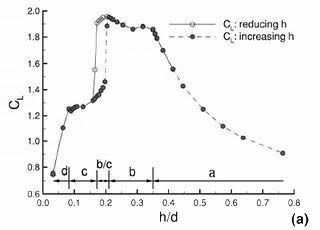
Maximizing the downforce of the diffuser is, however, a subtle issue. The downforce generated by a diffuser is a function of two variables: (1) the angle of the diffuser, and (2) the height above the ground. Generally speaking, the peak downforce of the diffuser increases with the angle of the diffuser. Then, for a fixed diffuser angle, the downforce generated will increase according to an exponential curve as the height reduces, until a first critical point is reached (see diagram above, taken from Ground Effect Aerodynamics of Race Cars, Zhang, Toet and Zerihan, Applied Mechanics Reviews, January 2006, Vol 59, pp33-49). As the height is reduced further, the downforce will increase again, but according to a linear slope, until a second critical point is reached, after which the downforce falls off a cliff.
Without running any rake, the diffuser is limited by regulation to a shallower angle than seen in years gone by. By increasing the rake, the effective angle of the diffuser is increased, thereby increasing the potential peak downforce. However, increasing the rake also has the effect of increasing the height of the diffuser.
So, how does one combat the detrimental effect of increasing the height of the diffuser? Well, the key, I think, is to understand exactly how a reduction in height increases the downforce generated by a diffuser. The crucial point is that the edges of the diffuser generate a pair of counter-rotating vortices, and the magnitude of the downforce generated is determined by the strength of these vortices. The downforce increases exponentially as the height is reduced, because the strength of these vortices is increasing. The first critical point corresponds to the height at which the vortex strength begins to decrease, and the second critical point corresponds to the height at which the vortices breakdown.
So, to pose the question again, how do we mitigate the downforce-reducing effect of an increase in diffuser height? Simple, one merely uses the exhaust gases to boost the strength of the side-edge vortices to levels otherwise seen at lower heights.
In fact, this is to simplify the issue, because the exhaust gases playing on the sides of the diffuser have two effects: (1) to strengthen the side-edge vortices inside the diffuser, and (2) to act as air curtains, preventing the ingress of turbulent air created by the rotating rear wheels.
So, with exhaust-blown diffusers to be banned from next year, the trick will be to find other ways of boosting the strength of those side-edge vortices. Do so, and you'll still be able to run your car with a significant degree of rake.
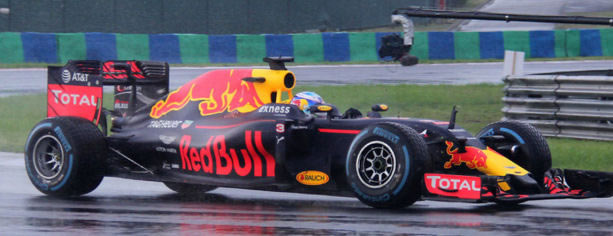
Daniel Ricciardo, Red Bull Racing RB12, 2016
 Ferrari SF1000, 2020
Ferrari SF1000, 2020






